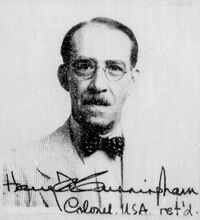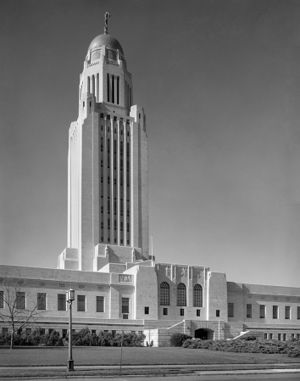Harry Francis Cunningham (1888-1959), Architect
Colonel Harry Francis Cunningham was a distinguished member of the architectural profession in Nebraska, first as the architect-in-charge of design development and construction documents for Bertram G. Goodhue Associates during the tower construction phase of the Nebraska Capitol, 1926-1930, then as founder and first chairman of the Department of Architecture in the College of Engineering at the University of Nebraska in 1930, where he served as chair until 1934. Cunningham enjoyed a rich and varied career, both in the U. S. Army, and as an architect practicing in Washington, D. C., New York, St. Petersburg, Florida, and Lincoln, Nebraska.
Cunningham was born in Washington, D. C. on April 15, 1888. After high school he studied both in the United States and France, taking his first architecture job back home with the supervising architects of the U. S. Treasury in 1907. His military career began with World War I, after which he returned to architecture from 1919 until 1939, when he again resumed military duties as an intelligence officer and strategic planner. In 1949 he returned to Lincoln where he remained until his death on April 25, 1959. He was a member of American Legion Post 3, the Roundtable, and the American Institute of Architects, which elected him Fellow in 1955.[1][2][3][5][6][10][15][16]
This page is a contribution to the publication, Place Makers of Nebraska: The Architects. See the format and contents page for more information on the compilation and page organization.
Contents
Compiled Nebraska Directory Listings
Lincoln, Nebraska, 1949-1951, 1953-1958
Educational & Professional Associations
1894-1905: Public Schools, Washington D.C.[5]
ca. 1906-1907: student, Worcester Polytechnic Institute, Worcester, Massachusetts.[5]
ca. 1907-1908: student, Beaux-Arts Institute of Design, New York, New York.[5]
ca. 1908-1909: student, Columbian University (now George Washington), Washington D.C.[5]
ca. 1909-1910: student, Atelier Julien, Paris, France.[5]
1907-1911: draftsman and designer, Wood Donn & Deming, Architects: Supervising Architects of the U.S. Treasury Department, Washington, D.C.[3][5][6][a]
1911-1917: partner with Clarke Waggaman and T. B. Everman, Architects, Washington, D. C.[5]
1917-1919: Captain and Major, Machine Guns, U.S. Army.[5]
1917-1947: student at various military schools, including Command and General Staff Schools, Armed Forces Staff College, National War College, and the French Ecole Supericure de Guerre, Paris, France.[5]
1919-1922: volunteer architect without compensation, French Government.[5][c]
1922: joined the American Institute of Architects.[7]
1922-1927: Harry F. Cunningham, Architect, Washington D.C. and St. Petersburg, Florida.[5][a]
1923-1924: Professor of Architecture, George Washington University, Washington, D. C.[3][6]
1925-1926: Lecturer in the Theory of Design, New York University.[3]
1926-1930: Architect-in-charge for the Nebraska Capitol tower, Bertram Grosvenor Goodhue Associates, Architects, New York, New York.[3][5][6][8][9][a]
1930-1934: Professor of Architecture and Chairman of Department, University of Nebraska, Lincoln, Nebraska.[1][3][5][8][15][a][b]
1934-1939: Harry F. Cunningham, Architect, Washington D. C.[5][a]
1939-1948: Intelligence Officer and Strategic Planner, U. S. Army.[5][a]
1949: Registered Professional Architect, Nebraska, March 4, 1949; A-214.[5][d]
1950-1954: member and professional advisor, Capitol Murals Commission, Lincoln.[3][12][13]
1952-1957: listed in directories and phone books as residing in Lincoln.
Buildings & Projects
Dated
Burning Tree Club (1923), Washington, D. C. vicinity.[5]
Dennis-McCarthy Hotel (1924-1926), 326 First Ave N, St. Petersburg, Florida.[6]
Lakewood Elementary School (1925-1926), St. Petersburg, Florida.[3][6]
Salvation Army Citadel (1925-1926), St. Petersburg, Florida.[3][5][6]
St. Petersburg Times Bldg (1926-1927), St. Petersburg, Florida.[6]
Remodel, Brazilian Embassy Bldg (1935), Washington, D. C.[3][5][6]
Heatherington Apartments (1936), Washington, D. C.[3][5][6]
Brazilian Chancery (1936), Washington, D. C.[3]
German Embassy (1938), Washington, D.C.[11][e]
Consulting architect, Memorial Chapel (1949-1952), Westminster Presbyterian Church, 2110 Sheridan, Lincoln, Nebraska.[3][4][f]
Undated
Penn-Flora Arcade (n.d.), St. Petersburg, Florida.[5]
Shuffle Board Club (n.d.), for the City of St. Petersburg, Florida.[5]
Publications & Exhibitions
Harry Francis Cunningham, The Capitol, Lincoln, Nebraska ([Lincoln]: The Capitol Commission, 1931).
_____. “The Capitol Murals,” Guest Editorial, Lincoln Star (April 20, 1951): 4:1.
_____. The Capitol, Lincoln, Nebraska: An Architectural Masterpiece. Lincoln: Johnson Publishing Co., 1954.
_____. "New Governmental Structures in the Far East: A Study Based upon the Constitutions of the States Concerned." Masters Thesis, University of Nebraska, Lincoln, 1953.
_____. “A Record of Successful Experiments,” American Architect 146:2626 (October 1934): 15-23.
_____. Sleeping Beauty. S. l.: William Dana Orcutt, 1926. [limited edition of 100 copies] See Worldcat.org, http://www.worldcat.org/title/sleeping-beauty/oclc/18105200 Accessed October 12, 2011.
_____, and Joseph Arthur Younger, [and] J. Wilmer Smith. Measured Drawings of Georgian Architecture in the District of Columbia, 1750-1820. Washington: Architectural Book Publishing Co., 1914.
Honors & Awards
1936: Outstanding Building of the Year, Washington Board of Trade (Brazilian Chancery).[3]
ca. 1946: recipient, French Legion of Honor, WWII.[16]
1955: elected Fellow of the American Institute of Architects.[7][15]
Notes
a. Additional information can be found in the original document.[5]
b. He founded the architecture program in 1930.[1][8]
c. Developed reconstruction plans for seventeen villages in the Aisne region, and plans for the extension of Laon, etc.[5]
d. His registration lapsed on December 31, 1952, and he was re-registered on July 11, 1953. He was also registered in the District of Columbia, New York, Florida, Maryland, and Tennessee.[5]
e. Cunningham resigned from the commission in 1939 when Germany invaded Czechoslovakia.[11]
f. Working with Hazen & Robinson, Architects, Lincoln, Nebraska.
References
1. Robert E. Knoll, Prairie University: A History of the University of Nebraska (Lincoln: University of Nebraska Press, 1995), 83.
2. AIA Historical Directory of American Architects: A Resource Guide to Finding Information About Past Architects, accessed April 20, 2010, http://communities.aia.org/sites/hdoaa/wiki/Wiki%20Pages/ahd1009605.aspx
3. American Institute of Architects, comp. American Architects Directory, First Ed. (New York: R. R. Bowker Co., 1956), 120, accessed March 3, 2010, http://communities.aia.org/sites/hdoaa/wiki/Wiki%20Pages/1956%20American%20Architects%20Directory.aspx
4. Tom Kaspar, comp. Inventory of architectural records in the archives of Davis Fenton Stange Darling, Architects (Lincoln, Nebraska. 1996). Nebraska State Historical Society, RG3748, Box 16.
5. Application for Registration to Practice Professional Engineering and Architecture, Nebraska State Board of Examiners for Professional Engineers and Architects, December 15, 1948. Nebraska State Historical Society RG081 SG2.
6. “Colonel Harry F. Cunningham,” website of the City of St. Petersburg, Florida, Historic Preservation Program, accessed October 12, 2011, http://www.stpete.org/historic_preservation/history_of_st_petersburg/notable_architects/colonel_harry_f_cunningham.asp
7. “Harry Francis Cunningham,” archINFORM website, accessed October 12, 2011, http://eng.archinform.net/arch/202992.htm
8. Ellery Lothrop Davis, “Harry F. Cunningham, FAIA,” TS (typed on Francis Cunningham stationary, with handwritten note from Francis to Larry Sommer, director, Nebraska State Historical Society, May 7, 1994).
9. Dale L. Gibbs, “An Architectural Album: Lincoln Historic Houses,” Preservation Association of Lincoln, Brownbag Lecture Series, Nebraska State Historical Society, October 11, 2011.
10. R. McLaran Sawyer, Centennial History of the University of Nebraska. II The Modern University, 1920-1969 (Lincoln: Centennial Press, 1973), 77.
11. “Bill Would Pay Lincoln Man For Designing Nazi Embassy,” Lincoln Journal-Star (January 25, (1953).
12. “Col. Harry Cunningham Is Persuaded To Rejoin Capitol Mural Commission,” Lincoln Star (March 3, 1953), 3:7.
13. “Capitol Murals,” in “The People Speak,” Lincoln Star (November 3, 1954), 4:7.
14. “Capitol Murals,” in “The People Speak,” Lincoln Star (July 2, 1954), 6:4.
15. “Col. Cunningham Is AIA Fellow,” Lincoln Star (June 24, 1955), 9:3.
16. “Cunningham,” Lincoln Star (April 27, 1959; April 29, 1959); Lincoln Journal (April 27, 1959; April 28, 1959).
Page Citation
D. Murphy, “Harry Francis Cunningham (1888-1959), Architect,” in David Murphy, Edward F. Zimmer, and Lynn Meyer, comps. Place Makers of Nebraska: The Architects. Lincoln: Nebraska State Historical Society, October 12, 2011. http://www.e-nebraskahistory.org/index.php?title=Place_Makers_of_Nebraska:_The_Architects Accessed, December 13, 2025.
Contact the Nebraska State Historic Preservation Office with questions or comments concerning this page, including any problems you may have with broken links (see, however, the Disclaimers link at the bottom of this page). Please provide the URL to this page with your inquiry.

